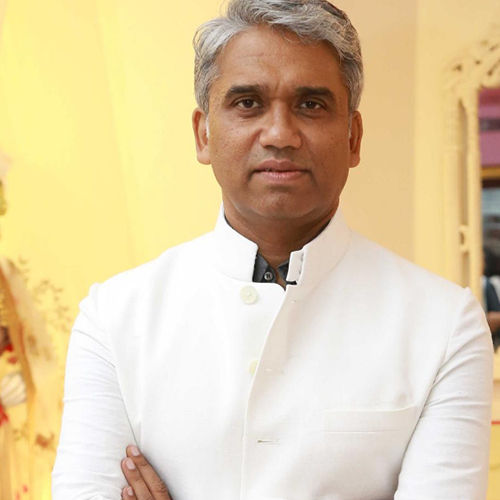
Rajesh Pratap Singh
Fashion designer
Rajesh Pratap Singh
I understand the fibre much more now
Fibre2Fashion: Last season at Lakme Fashion Week Summer/Resort 2018, 100 per cent Tencel yarns were blended with silk and stainless steel in eye-catching weaves like hopsack, waffle and herringbone. The fabric presented Tencel in an amazing array of options by using hi-tech; air-jet shuttle-less and power looms to traditional handlooms. Please tell us more.
Rajesh Pratap Singh:
This time, we are calling the collection "Welcome to the Jungle". Tencel is about sustainability and we are doing a whole collection, which refers in bits to the jungle. It is about developing the fibre into an interesting yarn. At a low-tech level it is hand spinning, and on the other it's hi-tech mills. We are working with important mills that are dedicated to sustainability. One is Arvind, and also the spinning that we are doing in Rajasthan and West Bengal. We are making fabrics in different parts of the country. We are using both technologies together, and Indian clothing will inspire things. We have worked on the experiment, which is now more evolved. We have taken the fibre and spun it in different ways. The idea is to introduce traditional craftsmen and traditional weaves into this fibre to make it truly sustainable.
F2F: Colour blocking was at the centre of attraction, while a mélange of hand block, digital as well as screen prints completed the list of techniques used for your last collection. What is the difference this time?
RPS:
We are doing prints, but we are also doing the same motifs in prints and through weaves. We are doing brocades in Benaras, chanderis and jamdanis in Kota. At our studio, we are using various kinds of weaving techniques, and we also use hi-tech machine looms.
F2F: There was an interplay of opposites in the collection as soft and hard, transparent and opaque, as well as fluid and unwavering, that were created into jackets and fluid drapes last season. What does the new collection look like?
RPS:
This time we are working more on Indian silhouettes like the poshak from Rajasthan which is an attempt to do a new idea with Indian dancers' costumes. We are doing an interpretation wherein you can wear these clothes anywhere with a strong influence on Indian costumes. The colours will be warm and earthy.
F2F: What is the look this season, and what blends will you have with Tencel?
RPS:
There will be men's and women's clothes that you can wear in Mumbai or New York. They are modern and easy to wear. The references are from Indian dancers' wedding costume poshak from Rajasthan; interesting crafts are brought in a new way with lots of experimentation. There will be some stripes, but the major part will be motifs woven or printed for the Indian collection with more earthy tones. The first lot of garments will be pure Tencel and off-white. Then the colours build up, and it comes to an end with lots of colour. But whatever we do, I don't want to send out a literal message. There are layers to every collection; every story will have a lot of stories in themselves. If there is a print, there is a reason for it. Each print will have five different stories. It's not a beautiful flower that I will slap on a strange looking garment. There will be blends of silk, wool and cotton. The trick is in the fibre, which we have twisted. We will have waffle weaves, but the fibre is now made into yarn; and that is the interesting part.
F2F: How has working with Tencel helped in your collections?
RPS:
I understand the fibre much more now. I am trying to do blends with wool and silk. Last time we did some silk. This time wool/silk is tried to get drape-ability in a rigid structure.
F2F: Did you incorporate Tencel in your fabric weaves for the other collections?
RPS:
No, we are making 100 per cent Tencel and blends of Tencel. I have a huge collection with lots of experiments. Tencel would be 20 per cent in our other collections. I have an R&D space, which does lots of handlooms, which is done in the studio. We keep making new textiles. Some of them can go into the industry where they are mass-produced. My job is of an R&D person; I keep making new things.
F2F: What are the advantages and disadvantages of working with Tencel?
RPS:
The advantages are that we know where the fibre is coming from. We know it's the most sustainable fibre, which is man-made and at times it's more sustainable than natural fibre. The source is natural, there is drape-ability, absorbency, and the colours are much stronger. The disadvantage at the moment is that it's produced in Austria. So, before joining this project I went back as I wanted to know the carbon footprint. Only when I was convinced about the positive carbon footprint that I took it up. Tencel is a much-refined product, the process is different, and the sustainability angle is different too.
F2F: How aware is the designer community about Tencel and its properties?
RPS:
I am trying to help my colleagues and educate them.
F2F: Has Tencel made an impact on the sale of your garments?
RPS:
This is the second season. In the first season we sold in India and outside.
Bill D’Arienzo
Rahul Mehta
Fanny Vermandel
Abhay Gupta
Pradip Mehta
Aseem Prakash
Anurag Batra
Arun Sirdeshmukh
Rahul Mehta
Gabi Seligsohn











_8.JPG)

